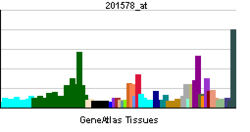PODXL
| View/Edit Human | |||
Podocalyxin-like protein 1 is a protein that in humans is encoded by the PODXL gene.[2]
Function
This gene encodes a member of the sialomucin protein family. The encoded protein was originally identified as an important component of glomerular podocytes. Podocytes are highly differentiated epithelial cells with interdigitating foot processes covering the outer aspect of the glomerular basement membrane. Other biological activities of the encoded protein include: binding in a membrane protein complex with Na+/H+ exchanger regulatory factor to intracellular cytoskeletal elements, playing a role in hematopoetic cell differentiation, and being expressed in vascular endothelium cells and binding to L-selectin.[2]
Interactions
PODXL has been shown to interact with Sodium-hydrogen exchange regulatory cofactor 2.[3][4][5]
References
- ↑ "Human PubMed Reference:".
- 1 2 "Entrez Gene: PODXL podocalyxin-like".
- ↑ Meder D, Shevchenko A, Simons K, Füllekrug J (Jan 2005). "Gp135/podocalyxin and NHERF-2 participate in the formation of a preapical domain during polarization of MDCK cells". The Journal of Cell Biology. 168 (2): 303–13. doi:10.1083/jcb.200407072. PMC 2171597
 . PMID 15642748.
. PMID 15642748. - ↑ Takeda T, McQuistan T, Orlando RA, Farquhar MG (Jul 2001). "Loss of glomerular foot processes is associated with uncoupling of podocalyxin from the actin cytoskeleton". The Journal of Clinical Investigation. 108 (2): 289–301. doi:10.1172/JCI12539. PMC 203027
 . PMID 11457882.
. PMID 11457882. - ↑ Li Y, Li J, Straight SW, Kershaw DB (Jun 2002). "PDZ domain-mediated interaction of rabbit podocalyxin and Na(+)/H(+) exchange regulatory factor-2". American Journal of Physiology. Renal Physiology. 282 (6): F1129–39. doi:10.1152/ajprenal.00131.2001. PMID 11997330.
Further reading
- Maruyama K, Sugano S (Jan 1994). "Oligo-capping: a simple method to replace the cap structure of eukaryotic mRNAs with oligoribonucleotides". Gene. 138 (1-2): 171–4. doi:10.1016/0378-1119(94)90802-8. PMID 8125298.
- Kershaw DB, Beck SG, Wharram BL, Wiggins JE, Goyal M, Thomas PE, Wiggins RC (Jun 1997). "Molecular cloning and characterization of human podocalyxin-like protein. Orthologous relationship to rabbit PCLP1 and rat podocalyxin". The Journal of Biological Chemistry. 272 (25): 15708–14. doi:10.1074/jbc.272.25.15708. PMID 9188463.
- Kershaw DB, Wiggins JE, Wharram BL, Wiggins RC (Oct 1997). "Assignment of the human podocalyxin-like protein (PODXL) gene to 7q32-q33". Genomics. 45 (1): 239–40. doi:10.1006/geno.1997.4934. PMID 9339384.
- Suzuki Y, Yoshitomo-Nakagawa K, Maruyama K, Suyama A, Sugano S (Oct 1997). "Construction and characterization of a full length-enriched and a 5'-end-enriched cDNA library". Gene. 200 (1-2): 149–56. doi:10.1016/S0378-1119(97)00411-3. PMID 9373149.
- Sassetti C, Tangemann K, Singer MS, Kershaw DB, Rosen SD (Jun 1998). "Identification of podocalyxin-like protein as a high endothelial venule ligand for L-selectin: parallels to CD34". The Journal of Experimental Medicine. 187 (12): 1965–75. doi:10.1084/jem.187.12.1965. PMC 2212365
 . PMID 9625756.
. PMID 9625756. - Dias Neto E, Correa RG, Verjovski-Almeida S, Briones MR, Nagai MA, da Silva W, Zago MA, Bordin S, Costa FF, Goldman GH, Carvalho AF, Matsukuma A, Baia GS, Simpson DH, Brunstein A, de Oliveira PS, Bucher P, Jongeneel CV, O'Hare MJ, Soares F, Brentani RR, Reis LF, de Souza SJ, Simpson AJ (Mar 2000). "Shotgun sequencing of the human transcriptome with ORF expressed sequence tags". Proceedings of the National Academy of Sciences of the United States of America. 97 (7): 3491–6. doi:10.1073/pnas.97.7.3491. PMC 16267
 . PMID 10737800.
. PMID 10737800. - Takeda T, McQuistan T, Orlando RA, Farquhar MG (Jul 2001). "Loss of glomerular foot processes is associated with uncoupling of podocalyxin from the actin cytoskeleton". The Journal of Clinical Investigation. 108 (2): 289–301. doi:10.1172/JCI12539. PMC 203027
 . PMID 11457882.
. PMID 11457882. - Li Y, Li J, Straight SW, Kershaw DB (Jun 2002). "PDZ domain-mediated interaction of rabbit podocalyxin and Na(+)/H(+) exchange regulatory factor-2". American Journal of Physiology. Renal Physiology. 282 (6): F1129–39. doi:10.1152/ajprenal.00131.2001. PMID 11997330.
- Schopperle WM, Kershaw DB, DeWolf WC (Jan 2003). "Human embryonal carcinoma tumor antigen, Gp200/GCTM-2, is podocalyxin". Biochemical and Biophysical Research Communications. 300 (2): 285–90. doi:10.1016/S0006-291X(02)02844-9. PMID 12504081.
- Koop K, Eikmans M, Baelde HJ, Kawachi H, De Heer E, Paul LC, Bruijn JA (Aug 2003). "Expression of podocyte-associated molecules in acquired human kidney diseases". Journal of the American Society of Nephrology. 14 (8): 2063–71. doi:10.1097/01.ASN.0000078803.53165.C9. PMID 12874460.
- Brandenberger R, Wei H, Zhang S, Lei S, Murage J, Fisk GJ, Li Y, Xu C, Fang R, Guegler K, Rao MS, Mandalam R, Lebkowski J, Stanton LW (Jun 2004). "Transcriptome characterization elucidates signaling networks that control human ES cell growth and differentiation". Nature Biotechnology. 22 (6): 707–16. doi:10.1038/nbt971. PMID 15146197.
- Economou CG, Kitsiou PV, Tzinia AK, Panagopoulou E, Marinos E, Kershaw DB, Kerjaschki D, Tsilibary EC (Jul 2004). "Enhanced podocalyxin expression alters the structure of podocyte basal surface". Journal of Cell Science. 117 (Pt 15): 3281–94. doi:10.1242/jcs.01163. PMID 15226400.
- Somasiri A, Nielsen JS, Makretsov N, McCoy ML, Prentice L, Gilks CB, Chia SK, Gelmon KA, Kershaw DB, Huntsman DG, McNagny KM, Roskelley CD (Aug 2004). "Overexpression of the anti-adhesin podocalyxin is an independent predictor of breast cancer progression". Cancer Research. 64 (15): 5068–73. doi:10.1158/0008-5472.CAN-04-0240. PMID 15289306.
- Suzuki Y, Yamashita R, Shirota M, Sakakibara Y, Chiba J, Mizushima-Sugano J, Nakai K, Sugano S (Sep 2004). "Sequence comparison of human and mouse genes reveals a homologous block structure in the promoter regions". Genome Research. 14 (9): 1711–8. doi:10.1101/gr.2435604. PMC 515316
 . PMID 15342556.
. PMID 15342556. - Meder D, Shevchenko A, Simons K, Füllekrug J (Jan 2005). "Gp135/podocalyxin and NHERF-2 participate in the formation of a preapical domain during polarization of MDCK cells". The Journal of Cell Biology. 168 (2): 303–13. doi:10.1083/jcb.200407072. PMC 2171597
 . PMID 15642748.
. PMID 15642748. - Casey G, Neville PJ, Liu X, Plummer SJ, Cicek MS, Krumroy LM, Curran AP, McGreevy MR, Catalona WJ, Klein EA, Witte JS (Mar 2006). "Podocalyxin variants and risk of prostate cancer and tumor aggressiveness". Human Molecular Genetics. 15 (5): 735–41. doi:10.1093/hmg/ddi487. PMID 16434482.
- Butta N, Larrucea S, Alonso S, Rodriguez RB, Arias-Salgado EG, Ayuso MS, González-Manchón C, Parrilla R (2006). "Role of transcription factor Sp1 and CpG methylation on the regulation of the human podocalyxin gene promoter". BMC Molecular Biology. 7: 17. doi:10.1186/1471-2199-7-17. PMC 1481587
 . PMID 16684343.
. PMID 16684343.
